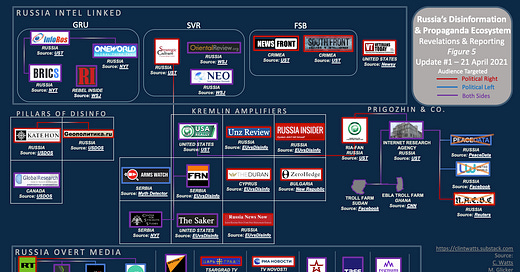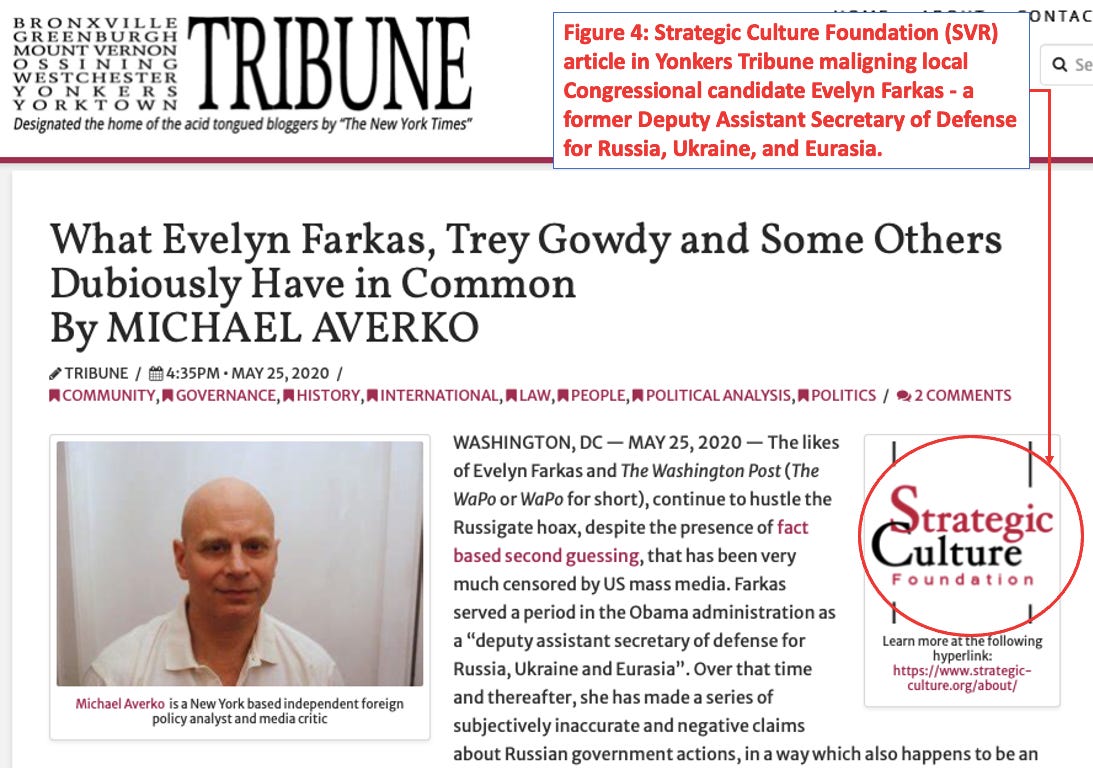Russia's Disinformation Ecosystem - A Snapshot
New Sanctions And Research Show How Americans Consume Kremlin Disinformation & Propaganda
It’s finally happened. Seven years after my colleagues and I encountered and began tracking Russian disinformation proliferating on the Internet and swirling on social media platforms, the U.S. government has begun a holistic effort to disrupt Putin’s digital propaganda machine.
On Thursday, April 15, 2021, the U.S. Treasury Department issued wide-ranging sanctions against many elements operating online and on-the-ground involved in U.S. election interference efforts. Specifically, these sanctions revealed four additional information outlets to be connected to Russian intelligence services. SouthFront and NewsFront were described as receiving “taskings” and working with officers from Russian domestic intelligence—the FSB.
Strategic Culture Foundation, another one of the designated outlets, is “an online journal registered in Russia that is directed by the SVR and closely affiliated with the Russian Ministry of Foreign Affairs.” The SVR is Russia’s foreign intelligence service. And Strategic Culture? Well, that’s the outlet that curiously had an article placed in an online local Yonkers, New York newspaper last May of 2020 —an article that derided former Department of Defense Assistant Secretary Evelyn Farkas and alleged a “Russiagate hoax” just before the local Democratic Congressional primary where candidate Farkas vied for the nomination (See Figure 4).
Finally, the Treasury designations outed news outlet InfoRos as run by the GRU—Russia’s military intelligence. Of critical importance in this declaration was some specific text:
InfoRos used a network of websites, including nominally independent websites, to spread false conspiracy narratives and disinformation promoted by GRU officials.
Four years ago, Americans were surprised that many of the political partisans they encountered on Twitter and Facebook were actually fake Russian accounts impersonating Americans operated from a troll farm in St. Petersburg. Hearings and investigations revealed the GRU’s hacks were real and damaging, that the Kremlin’s trolls duped us with conversations and memes and, in some instances, even persuaded Americans to attend political rallies of their own making, convincing one woman to dress up as Hillary Clinton and climb into a cage in front of a Florida Cheesecake Factory.
Overlooked in the broad discussion about election interference efforts has been the payload delivered by the Kremlin’s disinformation machine—the messages Putin’s minions seek to disseminate inside America and where those messages are generated. The sources of disinformation are not singular but many, and seek to subvert not one political or social group but all, hoping to demobilize establishment politicians, undermine elected officials and the democratic institutions they represent, and generally erode trust and confidence in democracy as a system of governance. The messages mirror each other in some cases, contradict each other in others, appear overtly some days and covertly in social media posts on other days. But the goal is always the same: Shift American perceptions of Russia and U.S. policies toward Russia to Putin’s advantage, while pitting Americans against each other in ways that shake the political and social stability of the country.
Some good news though: In 2020, the U.S. did much better fending off Russian interference in the election. U.S. government agencies, social media companies and mainstream media outlets all improved their game. But it’s still difficult to understand how all of the pieces fit together. Fact-checking outlets like EUvsDisinfo have posted many reports over the years noting Kremlin connections or suspected sponsorship to disinformation campaigns and the websites that propagate them. Last week brought the Treasury Department’s sanctions. Last summer, the Department of State’s Global Engagement Center (GEC) revealed Russian connections to various outlets in its “Russia’s Pillars of Disinformation and Propaganda” special report. Sprinkled in between were disclosures of Kremlin connections and sponsorship in the New York Times, Washington Post, Wall Street Journal, CNN, NBC News, and the Daily Beast. Every month, Facebook’s shutdowns of social media accounts revealed in dribs and drabs the expansive nature of Russia’s trolling and supporting infrastructure. Examining one outlet can infer the problem is small, but when one outlines the entire system, the full scope of the Kremlin disinformation effort to undermine democracy takes shape.
To keep a handle on the Kremlin’s propaganda and disinformation ecosystem, we’ve built Figure 5 above, which shows the range and type of Russian outlets revealed in a range of sources, offering a single location for researchers to connect disparate research and news reporting. The categories we’ll use for this diagram and future updates will be:
Russian Overt Media: Openly state-sponsored outlets
Russian Intelligence Linked: Websites with connections to Russian foreign (SVR), domestic (FSB) or military (GRU) intelligence
Pillars of Disinformation & Propaganda: Outlets discussed in the Department of State report from August 2020
Amplifiers: Those websites consistently amplifying pro-Kremlin narratives and discussed in a range of reports from fact-checking outlets and public reporting
Prigozhin & Co.: Part of the network associated with sanctioned Russian oligarch and owner of the notorious Internet Research Agency (IRA), Yevgeniy Prigozhin
As additional disclosures come in, we’ll continue to update Figure 5 and offer the sources for the disclosures.
I routinely run into Americans who don’t believe they encounter Kremlin disinformation or that if they did they would know it. This is unlikely. We found out four years ago that many Americans of all races, ethnicities, economic strata, social causes and political parties interacted with covert Russian accounts, repeated Kremlin lies, and shared Russian memes and propaganda.
Today, much of Russia’s disinformation is drowned out by—or simply repeats—American misinformation and disinformation. But during the COVID-19 pandemic and now, amid the global vaccine rollout, Kremlin disinformation and propaganda from outlets listed in Figure 5 has repeatedly drifted into my own social media feed. Since the pandemic started, my next-door neighbor from childhood posted a Global Research article claiming COVID-19 is a bioweapon; a high-school classmate shared a Sputnik News story proclaiming the FBI investigation into Russian interference was a hoax; a former U.S. Congresswoman posted a Kremlin outlet pushing a conspiracy about vaccine safety; and many on my Instagram and Twitter feeds shared George Floyd protest content from Redfish. One might wonder why a Russian-funded social media venture based in Berlin, Germany makes English-language content for Americans that showcases protests, racial inequalities, and political violence in America.
To get a better flavor for these outlets in Figure 5 and some of their popular nonsense one might encounter on social media, we also created the accompanying Figure 6 to help one understand the types of readers they attract and the headlines they produce. More updates to come as we learn more … the U.S. government appears to be back.
Thanks to Max, Rachel and Lukas and all of my research team for their hard work, analysis and graphic design skills.
FIGURE 6 - RUSSIA’S DISINFORMATION ECOSYSTEM DESCRIPTIONS







EXCELLENT WORK. PUTIN AND XI are a tag team too: https://dianefrancis.substack.com/p/ukraine-taiwan-and-the-bullies
Thank you..